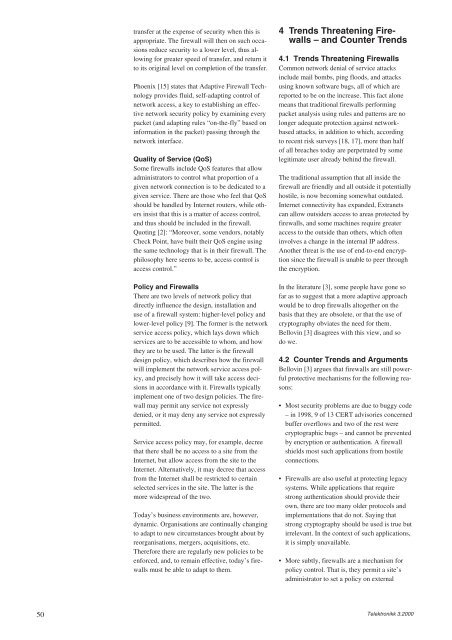Security - Telenor
Security - Telenor
Security - Telenor
Create successful ePaper yourself
Turn your PDF publications into a flip-book with our unique Google optimized e-Paper software.
50<br />
transfer at the expense of security when this is<br />
appropriate. The firewall will then on such occasions<br />
reduce security to a lower level, thus allowing<br />
for greater speed of transfer, and return it<br />
to its original level on completion of the transfer.<br />
Phoenix [15] states that Adaptive Firewall Technology<br />
provides fluid, self-adapting control of<br />
network access, a key to establishing an effective<br />
network security policy by examining every<br />
packet (and adapting rules “on-the-fly” based on<br />
information in the packet) passing through the<br />
network interface.<br />
Quality of Service (QoS)<br />
Some firewalls include QoS features that allow<br />
administrators to control what proportion of a<br />
given network connection is to be dedicated to a<br />
given service. There are those who feel that QoS<br />
should be handled by Internet routers, while others<br />
insist that this is a matter of access control,<br />
and thus should be included in the firewall.<br />
Quoting [2]: “Moreover, some vendors, notably<br />
Check Point, have built their QoS engine using<br />
the same technology that is in their firewall. The<br />
philosophy here seems to be, access control is<br />
access control.”<br />
Policy and Firewalls<br />
There are two levels of network policy that<br />
directly influence the design, installation and<br />
use of a firewall system: higher-level policy and<br />
lower-level policy [9]. The former is the network<br />
service access policy, which lays down which<br />
services are to be accessible to whom, and how<br />
they are to be used. The latter is the firewall<br />
design policy, which describes how the firewall<br />
will implement the network service access policy,<br />
and precisely how it will take access decisions<br />
in accordance with it. Firewalls typically<br />
implement one of two design policies. The firewall<br />
may permit any service not expressly<br />
denied, or it may deny any service not expressly<br />
permitted.<br />
Service access policy may, for example, decree<br />
that there shall be no access to a site from the<br />
Internet, but allow access from the site to the<br />
Internet. Alternatively, it may decree that access<br />
from the Internet shall be restricted to certain<br />
selected services in the site. The latter is the<br />
more widespread of the two.<br />
Today’s business environments are, however,<br />
dynamic. Organisations are continually changing<br />
to adapt to new circumstances brought about by<br />
reorganisations, mergers, acquisitions, etc.<br />
Therefore there are regularly new policies to be<br />
enforced, and, to remain effective, today’s firewalls<br />
must be able to adapt to them.<br />
4 Trends Threatening Firewalls<br />
– and Counter Trends<br />
4.1 Trends Threatening Firewalls<br />
Common network denial of service attacks<br />
include mail bombs, ping floods, and attacks<br />
using known software bugs, all of which are<br />
reported to be on the increase. This fact alone<br />
means that traditional firewalls performing<br />
packet analysis using rules and patterns are no<br />
longer adequate protection against networkbased<br />
attacks, in addition to which, according<br />
to recent risk surveys [18, 17], more than half<br />
of all breaches today are perpetrated by some<br />
legitimate user already behind the firewall.<br />
The traditional assumption that all inside the<br />
firewall are friendly and all outside it potentially<br />
hostile, is now becoming somewhat outdated.<br />
Internet connectivity has expanded, Extranets<br />
can allow outsiders access to areas protected by<br />
firewalls, and some machines require greater<br />
access to the outside than others, which often<br />
involves a change in the internal IP address.<br />
Another threat is the use of end-to-end encryption<br />
since the firewall is unable to peer through<br />
the encryption.<br />
In the literature [3], some people have gone so<br />
far as to suggest that a more adaptive approach<br />
would be to drop firewalls altogether on the<br />
basis that they are obsolete, or that the use of<br />
cryptography obviates the need for them.<br />
Bellovin [3] disagrees with this view, and so<br />
do we.<br />
4.2 Counter Trends and Arguments<br />
Bellovin [3] argues that firewalls are still powerful<br />
protective mechanisms for the following reasons:<br />
• Most security problems are due to buggy code<br />
– in 1998, 9 of 13 CERT advisories concerned<br />
buffer overflows and two of the rest were<br />
cryptographic bugs – and cannot be prevented<br />
by encryption or authentication. A firewall<br />
shields most such applications from hostile<br />
connections.<br />
• Firewalls are also useful at protecting legacy<br />
systems. While applications that require<br />
strong authentication should provide their<br />
own, there are too many older protocols and<br />
implementations that do not. Saying that<br />
strong cryptography should be used is true but<br />
irrelevant. In the context of such applications,<br />
it is simply unavailable.<br />
• More subtly, firewalls are a mechanism for<br />
policy control. That is, they permit a site’s<br />
administrator to set a policy on external<br />
Telektronikk 3.2000

















